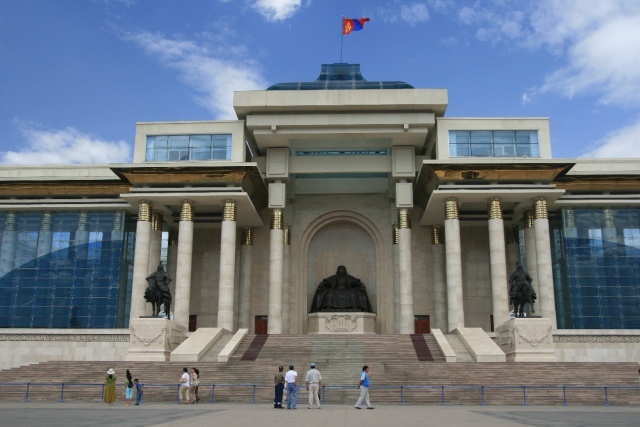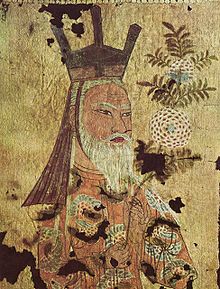
Silk Road Trade & Travel Encyclopedia
丝绸之路网站(丝路网站)
丝绸之路百科全书—游客、学生和教师的参考资源
İPEK YOLU ve YOLLARI ANSİKLOPEDİSİ
www.ipekyollari.net

Silk Road Trade & Travel Encyclopedia
丝绸之路网站(丝路网站)
丝绸之路百科全书—游客、学生和教师的参考资源
İPEK YOLU
ve YOLLARI
ANSİKLOPEDİSİ
www.ipekyollari.net
U
A B
C
D
E
F
G
H I
J
K
L
M
N O P
Q
R
S
T
U V
W
X
Y
Z
Uighur (See Uyghur)
Ulaanbaatar (Ulan Bator) is the capital of Mongolia, famous for its Gobi Desert, and the famous Eurasian ruler Genghis Khan. There are many sites to see in Ulaanbaatar, such as the summer and winter palaces, Buddhist monasteries, temples, Theater & Cinema Museum, Ulaanbaatar City Museum, Toy Museum, Opera House, Museum of Geology and Mineral Resources, Military History Museum, and Mongolian Hunting Museum. The National Museum of Mongolian History includes exhibits from prehistoric times, through the Mongol Empire, to the present day. It features the costumes and accessories of Mongolia's many ethnic groups, a collection of Mongol saddles, and a replica of a traditionally furnished circular nomadic tented home, called a "Ger," or yurt. The Natural History Museum features many dinosaur fossils and meteorites found in Mongolia, and covers geology, zoology, botany, and anthropology. Exhibits include the famous fighting dinosaurs, dinosaur nests, bone and fossil fragments of other ancient creatures, expedition material from anthropological digs, and the Golden Camel Museum. The Zanabazar Museum of Fine Arts contains a large collection of Mongolian art, including works of the 17th century sculptor Zanabazar, whose bronze figure of Buddha is on display. The Zaisan Memorial is a memorial to Soviet soldiers killed in World War II. There is also the Memorial Museum of the Victims of Political Repression, dedicated to the Mongolians who lost their lives in the 1930's purges. About 50 km from Ulan Bator is a 40 meter high Genghis Khan Equestrian Statue, which is the largest equestrian statue in the world. More...

A large stone image of the "world conqueror," Genghis Khan, sits in front of the Ceremonial Hall facing onto Suhbaatar Square.
What often comes to the minds of travelers is the vast, bleak expanses of the sparsely populated Gobi Desert. It was along the fringes of the Gobi Desert that merchants gathered, and from where Altaic (Turkic) nomadic tribes emerged and united to build powerful empires across Eurasia. The Gobi, which forms a natural land barrier between Mongolia and China, is home to a quarter of Mongolia's domestic camels. The desert is also famous for its cashmere goats and gazelles. In order to experience how Silk Road merchants and caravans crossed this region, tours can be arranged (one of the best ways to experience the Gobi is from the back of a camel). Modern-day Silk Road travelers can stay overnight in a "Ger" camp and see the famous Mongolian wild horses - the "takhi." More...
Ulugh Beg (Mīrzā Mohammad Tāregh bin Shāhrokh, 1393 - 1449) was a Timurid ruler as well as an astronomer, mathematician and sultan. Ulugh Beg was also notable for his work in astronomy-related mathematics, such as trigonometry and spherical geometry. He built the great observatory in Samarkand between 1424 and 1429. He was the grandson of the conqueror, Timur (Tamerlane) (1336–1405), and oldest son of Shah Rukh. Ulugh Beg was born in Sultaniyeh in Iran. As a child he travelled through a substantial part of the Middle East and India, as his grandfather expanded his conquests in those areas. With Timur's death, however, and the accession of Ulugh Beg's father to much of the Timurid Empire, he settled in Samarkand, which had been Timur's capital. After Shah Rukh moved the capital to Herat (in modern Afghanistan), sixteen-year-old Ulugh Beg became the shah's governor in Samarkand in 1409. In 1411, he became the sovereign ruler of the whole Mavarannahr khanate. More...
Ulugh Beg Observatory in Samarkand c. 1420
Ulugh Muztagh (Ulugh Muztag) is an extremely remote mountain group on the Northern Tibet plateau. Located on the border between the Tibetan Autonomous Region and Xinjiang Uyghur Autonomous Region in China, it is part of the main range of the Kunlun Mountains of Central Asia. There have been only a few attempts to climb Ulugh Muztagh and several of them have not been even able to reach the foot of the mountain due to impassable terrain at the elevation of 4300-5000 meters.
UNESCO (United Nations Educational, Scientific and Cultural Organization) China has been working together with UNESCO to preserve historic sites and relics along the ancient Silk Road (of which more than half is in China). UNESCO is a specialized agency of the United Nations established in 1945. Its stated purpose is to contribute to peace and security by promoting international collaboration through education, science, and culture in order to further universal respect for justice, the rule of law, and the human rights along with fundamental freedoms proclaimed in the UN Charter. UNESCO Sites in China
China itself is also investing energy and money in national projects and efforts to preserve its heritage and to protect key cultural relics along parts of the Silk Road, including the northwestern Xinjiang Uygur Autonomous Region. A series of museums have been established in China, and in China's Gansu Province to showcase rare cultural relics excavated along the ancient Silk Road. The network comprises numerous museums featuring Dunhuang art, the Great Wall, ancient animal fossils, coin collections, painted pottery, and the customs of ethnic minority groups residing along the Silk Road. In addition to Shaanxi and Henan provinces, Gansu has the highest quantity of culture relics in China. Experts have acknowledged that most of the cultural relics along the Silk Road have been defaced, or seriously damaged by environmental elements, including wind and rain erosion, desertification, and air pollution. Inadequate maintenance and human activities, especially tourism, are also blamed. Some 1,200 ancient relics sites -- mostly grottoes and earth houses and many under state protection -- are dotted along the 4,000-km Chinese section of the Silk Road. Frescoes and unearthed stoneware, bronzeware, and pottery from along the route are of high archaeological value. (Chinese Silk Road Section)
Ural The Ural river flows through Russia and Kazakhstan and forms part of the traditional boundary between Europe and Asia. It arises in the southern Ural Mountains and ends at the Caspian Sea. Its total length is 1,511 mi (2,428 km) makes it the third longest river in Europe after the Volga and Danube. In the 10–16th centuries, the city of Saray-Jük (or Saraichik, meaning "small Sarai") on the Ural River (now in Atyrau Province of Kazakhstan) was an important trade center on the Silk Road. In 13th century, it became a stronghold of the Golden Horde. It was destroyed in 1395 by the army of Timur, but then rebuilt to become the capital of Nogai Horde in the 15–16th centuries. It was reduced to a village in 1580 by the Ural Cossacks.
Ural Altaic languages constitute a language family uniting the Uralic and Altaic languages. The "Eurasiatic" hypothesis maintains that there is evidence of ties between Eurasian languages, and thus Finish, Hungarian, Turkish, and Mongolian are related. More...
Urho Ghost Castle is located in the Urho area of Xinjiang, China, about 100 km northeast of Karamay City, neighboring the Halahlat Mountain. The area is made-up of a rare landform that covers an area of about 30 square kilometers. After years of wind erosion, the hills here have been shaped into various figures. The native Mongolian people call the area “Sulumuhak,” while the local Kazakh people refer to it as “Shytirkrsi” -- both the two names have the same meaning ----Ghost Castle.
Urumqi (Urumchi) Urumqi is the capital of the Xinjiang Uyghur Autonomous Region in the People's Republic of China. Like the cities of Turpan and Kashgar, Urumqi is one of the centers of Uighur culture. The city is known as the most 'inland' city in the world, being the furthest from any major body of water. Urumqi has a population of two million, embedded at the foot of the Tianshan Mountains. The city is surrounded by the lofty ice-capped Bogda Peak and vast Salt Lake in the east; by the rolling pine-covered southern pastures, a well-known scenic district; and by the alternating fields and sand dunes of the Zunggar Basin in the northwest. Urumqi is strategically located along the ancient Silk Road, where the cultures of the east and west continue to mix. The most visited cultural sites and natural landscapes include the Aydingkol Lake (Moonlight Lake), Heavenly Lake, the Southern Pastures, the Red Hill, the Southern Mosque, the Tartar Mosque, the Karakhoja Tombs, the ancient city of Gaochang, and the Xinjiang Regional Museum. There are numerous oasis towns and Silk Road cities which can also be visited in Xinjiang, such as Aksu, Bayingolin, Bortala, Changji, Hami, Hetian (ancient Khotan), Karamay, and Kizilsu. Map




Uyghur (Uighur) The Uighurs are a Turkic people who ruled over a powerful empire between 744 and 840, north of the Gobi Desert. Also known as the Uyghur Khaganate, the empire stretched from the Caspian Sea to northeast China. Its capital was Karabalghasun (Ordu-Baliq) on the upper Orhon River in Mongolia. Although of nomadic origin, the Uighurs presided over flourishing commercial and agricultural centers. Kharabalghasun, the capital of the first Uyghur Empire, was built on the site of the former Göktürk imperial capital, near the later Mongol capital, Karakorum. After the disintegration of the Uighur Empire, the Uighurs created the kingdom of Kocho (Gaochang, a.k.a. Qocho, Karahoca) c. 860-1284, whose urban centers were in the Turfan oasis north of the Taklamakan Desert in present-day Xinjiang, PRC, astride the northern branch of the Silk Road. Beshbalik was the Uighur capital at the time of the Uighur submission to the Mongols (1209). It was one of the largest of 5 towns in the Uyghur Khaganate of Mongolia.
The Uyghurs are a Turkic-speaking ethnic group living in Eastern and Central Asia. In the People's Republic of China, the Uyghurs live primarily in the northwest Xinjiang Uyghur Autonomous Region, a region of many Silk Road cities and oasis towns. Smaller populations of Uyghurs live in the Central Asian republics. An estimated 80% of Xinjiang's Uyghurs live in the southwestern portion of the Tarim Basin region. Large diaspora communities of Uyghurs exist in the Central Asian countries of Kazakhstan, Kyrgyzstan, Uzbekistan, as well as in many major cities of the world. Uyghur history can be divided into four distinct phases: Pre-Imperial (300 BCE – 630 CE), Imperial (630–840 CE), Idiqut (840–1200 CE), and Mongol (1209–1600 CE), with perhaps a fifth modern phase running from the end of the Silk Road in 1600 CE until the present. During the late 19th and early 20th centuries, scientific and archaeological expeditions to the Uyghur regions of the Silk Road discovered numerous cave temples, monastery ruins, and wall paintings, as well as valuable miniatures, books, and documents - artistic treasures which amazed explorers from Europe, America, and Japan. The manuscripts and documents discovered in Xinjiang reveal the very high degree of civilization attained by the Uyghurs, a civilization which dominated Central Asia for over a thousand years. In modern usage, Uyghur often refers to settled Turkic urban dwellers and farmers who follow traditional Central Asian sedentary practices, as distinguished from nomadic Turkic populations in Central Asia. One of the first uses of Uyghur was during the interim period between the First and Second Göktürk Khaganates (630-684 CE).

An 8th century Uyghur Khagan
Chinese envoy Wang Yande (939–1006), sent to the Karakhoja Uyghur Kingdom in AD 981–984, is known to have stated: "I was impressed with the extensive civilization I have found in the Uyghur Kingdom. The beauty of the temples, monasteries, wall paintings, statues, towers, gardens, housings and the palaces built throughout the kingdom cannot be described. The Uyghurs skillfully make things of silver and gold, vases and pitchers." The cultivated Uyghurs become important civil servants, scribes, and administrators to most of Central Asia, especially during the era of Pax Mongolica when the Mongol Empire adopted the Uyghur script as its official script. More...
Uyghur Khaganate was an empire which stretched from the Caspian Sea to northeast China, and lasted from 744 to 840 CE. It was administered from the imperial capital Karabalghasun (Ordu-Baliq), one of the ancient cities of Mongolia. In some medieval geographical works and in historical sources, the Uyghur Empire was referred to as Uyghuristan (however, it is now considered a controversial political term). More...
Uyghur Script was used as a form of communication across the Silk Road, especially during the era of Pax Mongolica, when Uyghur became the official script of the Mongol Empire. The Mongols adopted the Uyghur script around the 12th century and selected well-educated Uyghurs as civil servants, scribes and administrators to most of Central Asia. The Mongol common law code, discipline and order impressed western travelers, such as the 13th century Franciscan traveler Piano Carpini. More...
Uzbekistan Many Ancient cities and regions of Uzbekistan were located on the ancient Silk Road, such as Samarkand, Bukhara, Khiva, Tashkent, and the Fergana Valley.
Silk Routes.net | Ipek Yollari.net